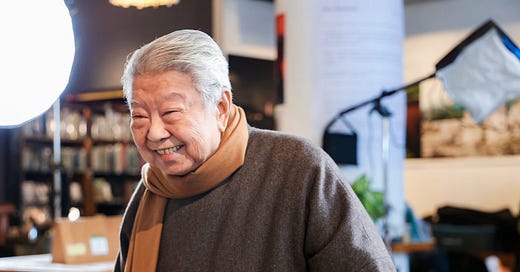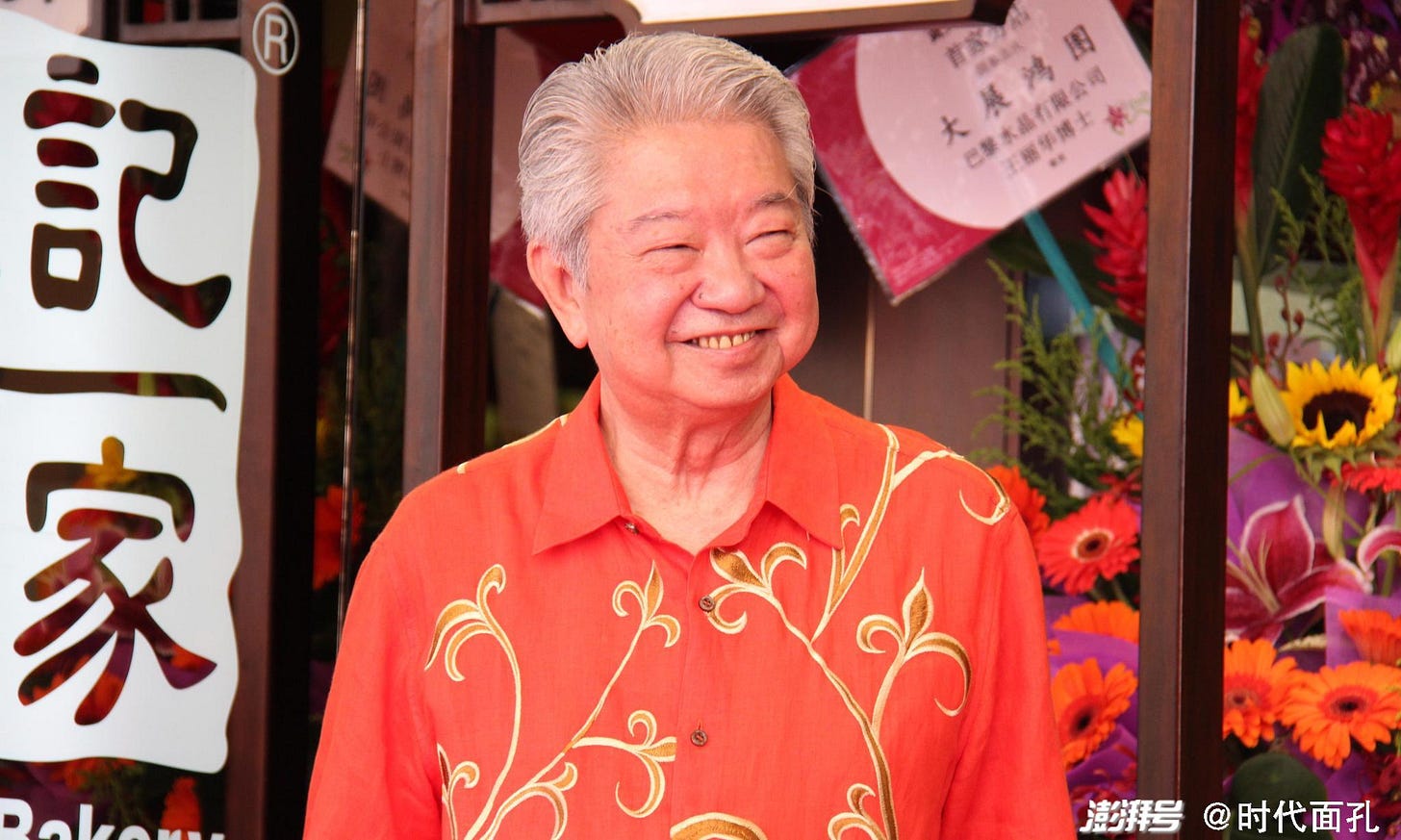On June 27, the Weibo account @蔡澜 announced: “Our beloved Mr. Cai Lan passed away peacefully at Hong Kong Sanatorium & Hospital on June 25 2025 (the first day of the sixth lunar month), with family and friends at his side. In accordance with his wishes, no services will be held so as not to disturb relatives and friends; his remains have already been cremated.” Cai Lan was born in 1941 in Singapore, with ancestral roots in Chaozhou, Guangdong. A film producer and executive producer, he helped create classics such as Wheels on Meals. Renowned as a gastronome, he developed a distinctive style of food criticism. He was also a prolific columnist, publishing more than 200 books. The programs he hosted were widely beloved, and he served as chief consultant for A Bite of China.
News of Cai Lan’s (蔡澜) passing drifted across Hong Kong’s high-rises and old streets like a damp South-China Sea breeze at the tail end of June. A terse Weibo notice said he had “left peacefully” and “been cremated,” a message as neat as his briefest food columns, leaving only an aftertaste to circle in the mind.
Most people remember him as one of the “Four Talents of Hong Kong,” alongside Jin Yong (金庸), Huang Zhan (黄霑), and Ni Kuang (倪匡). Yet what Cai shared with his three friends lay less in a contest of pen or wit than in a Confucian magnanimity and compassion: Jin Yong embodied chivalry, Huang Zhan spontaneity, Ni Kuang candor; Cai Lan infused daily eating with the same benevolence, lending rice, salt, oil, and soy their own measure of backbone and sentiment. Confucius observed that “food should not be coarse, meat not cut thick” (食不厌精,脍不厌细); in Cai’s hands the aphorism left the distant realm of classics and reappeared in rising steam, in a fish-maw soup brought to the precise shimmer, on the itinerant palate of a Teochew youth turned global wanderer, proving each day what the two characters for “delicious” can bear.
If Jin Yong reshaped the imaginative map of Chinese through wuxia, Ni Kuang wired Chinese letters to the future with science fiction, and Huang Zhan dyed an era’s mood in Cantonese lyrics, Cai Lan—with stomach and stylus—wrote an unchaptered chronicle of Chinese foodways. Born in the Nanyang world yet calling himself a “Lingnan lad,” he grew up between Teochew beef balls and Guangzhou morning tea, then honed his taste in Hong Kong’s wok-hei haze and Tokyo’s kaiseki delicacy, until every ingredient on earth felt like home. Others spoke of recipes and technique; Cai cared for people and heart: the cook’s sincerity, the eater’s reverence. He despised affectation, preached “the best ingredients for the simplest dishes”—a return-to-basics aesthetic rooted in the Confucian ethic of cheng, honesty.
Before mass media had packaged “gourmet” as entertainment, Cai already roamed alleys and coastlines with a handheld camera, capturing bursting oil bubbles and the flash of a cleaver on the board. Hosting “Cai Lan’s World of Tastes” (《蔡澜叹世界》), he spoke of Roman bread and North Indian curry, of Tainan danzai noodles and Tengchong rice-cakes, nodding and beaming at proprietresses while the phrase “so good it’s unreal” lodged in viewers’ imaginations. When “A Bite of China” (《舌尖上的中国》) arrived, he served as chief consultant, resisting commercial slickness and insisting on poetic, spare images that recorded the breath of food and soil. For countless audiences a single grain of rice, a vat of vinegar, a glistening suckling pig suddenly became vessels of civilization. After the series aired, “the taste of home” gained new resonance among Chinese worldwide, and Cai’s figure behind the project resembled the half-faded signboard above an old shop: modest, yet steady in its glow, reminding passers-by what authenticity means.
He published more than two hundred books—output surpassing many literary novelists—yet never styled himself a scholar. Writing, to him, simply lifted the small matter of “eating well” onto paper, luring readers back to the smoke and fire below with the scent of ink. “Cuisine is the art with the lowest threshold,” he liked to say—anyone with a mouth may enjoy and critique—yet true gastronomy demands knowing not only what but why. From the water temperature of Teochew kung-fu tea to the seasonal plating of Kyoto kaiseki to the oil-sheened clay pots of Cantonese dim sum, each step hides an accord of culture and climate. In his prose these whys never felt obscure; they sounded like neighborhood chatter—listen closely and “knowing flavor” turns to “understanding flavor.” His pride in “Eating in Guangzhou” rose into a cross-regional dialogue: Sichuan heat, Huaiyang subtlety, Fujian thickened broths—all conversed in festivals he curated or essays he penned, giving hometown tastes new vistas under the banner of “Chinese aesthetics.”
Among Hong Kong’s four talents Cai cared least for the title. Joking that “if no editor buys my words, I’ll go shoot a film,” he produced the 1980s Golden Harvest “Dragon Brothers” cycle; the fried-rice sequence in “Wheels on Meals” owed everything to him, and fans still call it “the fragrance of rice in an action flick.” In that moment his two passions—cinema and flavor—merged, marking the difference between him and his fellow talents: where a critic might discourse loftily, Cai would rather squat by the stove to cook an extra dish for crew, then toss off a line of commentary. This hands-on Confucianism kept his culinary aesthetics from floating away—if a feast cannot be shared and chewed, no matter how florid the writing, it remains paper fireworks.
“First be solid, then the Way emerges,” said Confucius. Cai’s solid had two facets. The first was precision, not luxury: an exacting respect for ingredients and heat; the second was joy. Eating must be fun, so on screen he laughed, in columns he cracked wordplay, book titles gleamed with street slang—“Cai Lan on Eating” (《蔡澜谈吃》), “I Love Soy Sauce” (《我爱酱油》), “Vietnam, Plain and Simple” (《越南快意》). Under the cheeky covers lay erudition: the taxonomy of Chinese soy sauces, the fish-sauce-lemongrass balance in Saigon noodle broth. Each detail read like a footnote borrowed from a Confucian banquet—tend to it with care, and the everyday leads to the sages.
Asked late in life what defined the perfect meal, Cai answered, “A few friends, a few plates, and conversation.” Without banter and feeling, food dissolves on contact, he said. The reply was at once Lingnan and Confucian and served as his lifelong testament: gastronomy, in the end, consummates relations between people and between people and earth. He never snubbed Michelin stars, yet treasured the lard crisps of a temple stall; he might savor kaiseki in Ginza, then crouch in a Fujian fishing village tearing into fire-roasted sea worms. Each seemingly casual bite relied on a palate trained to sense the difference between cloud and monsoon, and a heart willing to sit with strangers.
Now the spectacles and gentle crow’s-feet have slipped from view, and the city’s mourning is laced with a lightness hard to name. Perhaps because he long ago taught us that food is cyclical, as life is. Ashes after cremation return to dust, just as a feast ends with empty bowls; what endures are the nourished bodies, the awakened palates, the warmth lingering on tongue and lip. Some hail him “the foremost champion of Chinese culinary aesthetics,” yet he never consciously “championed” anything: he simply wrote by day, tasted by night, toasted friends, and salted the ordinary world. Aesthetics fermented quietly in readers and viewers, rising from sweet, sour, salty heat into tendrils of homesickness and dignity.
Cai Lan’s life resembled his beloved Teochew clay-pot porridge: rice grains simmered long enough to take in seafood’s brine, old ginger’s heat, cilantro’s brightness, until they gleamed like jade while keeping the grain’s own spirit. Just before extinguishing the flame, he would say, “Let the broth rest; the flavor will settle.” On the first day of the sixth lunar month he slipped away as gently as that pot leaving the stove, giving the world a moment to bow and listen to the simmer’s fading echo of homeland, fellowship, and temperament.
Night deepens in Hong Kong. In Causeway Bay a chef may still be flipping a wok, in Mong Kok the roast-meat stall’s fire is still bright. In that human smoke we might recall his refrain—“so good it’s unreal”—and remember how a gracious Teochew gentleman spent half a lifetime folding Lingnan’s (岭南) local culinary tradition into Confucius’s creed of refined eating, cooking a flavor map meant for every one of us.






